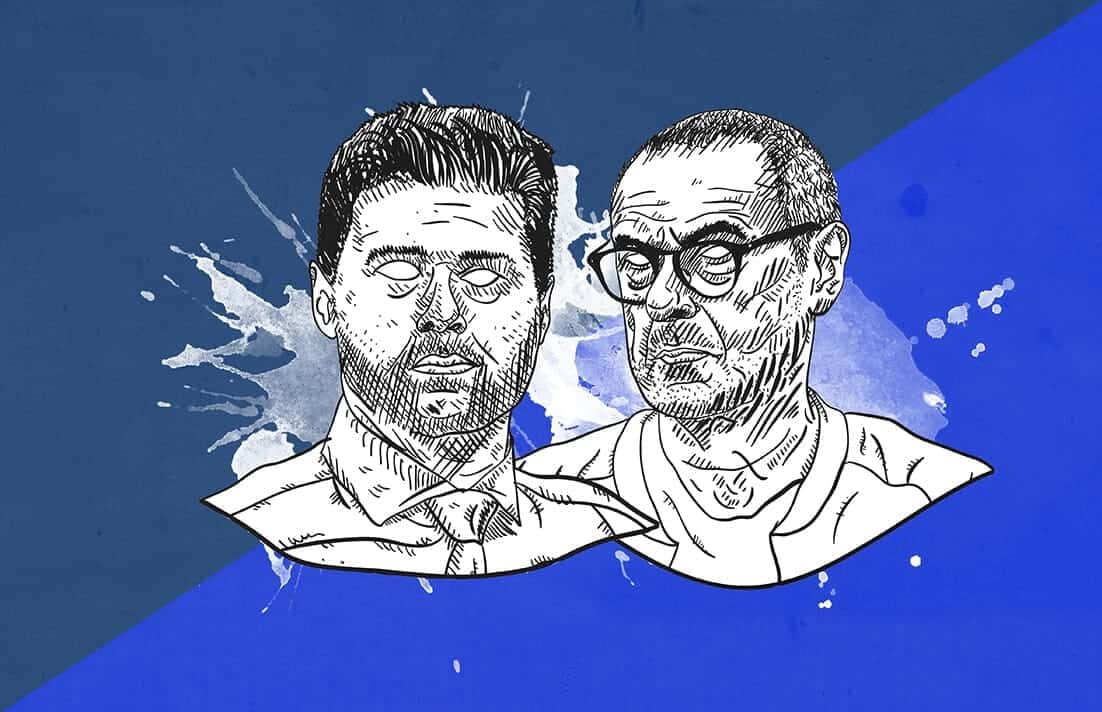Chelsea eventually faced their first defeat of the season as they went through one-third of the league. The 3-1 scoreline in the away fixture is a clear reflection of Chelsea’s worst defensive performance and also unidimensional build-up against Tottenham. Even after conceding an early goal against an indirect freekick didn’t bring any improvement in Chelsea’s approach neither defensively nor offensively. There wasn’t any change in strategy in the second half either. Chelsea was all open against Spurs like a toothless team.
Tottenham pressed at the front foot
The home team aggressively pushed Chelsea’s backline leaving no space for the build-up from the back. While Jorginho also constantly remain marked by Alli, the playmaking and distribution options of Chelsea were foregone.

Spurs were also able to concentrate their press on Chelsea’s frontline which tends to concentrate centrally due to Chelsea’s general tendency to prefer the middle lanes over the widths.

Spurs defended in a 4-4-2 diamond scheme which allowed them to keep intact centrally. This even left spaces in the flanks for Chelsea but the away team couldn’t exploit it, which must be due to its tendency to remain centrally intact while attacking.

Chelsea short of playmakers
With the proactive marking approach by Spurs, Chelsea’s build-up level was already down as they normally have with space in the midfield. The front-foot press from the away players completed blindfolded Luiz to execute any playmaking technique from the back. As a result, the away team turned to play long passes which eventually got it to lose possession to its opponents due to the stepped-up backline of the latter to block Blues’ front line. This, along with marked Jorginho, cost Chelsea going down in distribution, playmaking, and possession. Overall, Chelsea could only enjoy 38 per cent of the possession. All because Sarri has not many options to ensure effective distribution of ball across the pitch, let alone playmaking.

It’s not just being unsuccessful in getting up to either end of the pitch using distribution but also the team’s ability to retain possession in its own half which has a strong bearing on Chelsea’s lack of effective playmakers. The away team lost possession in its own half and conceded short counters, which is very dangerous of a team with no defensive discipline during defending transitions.
Chelsea vulnerable in the defensive phase
Chelsea was highly exposable in defensive phases, as highlighted by Sarri after the match. The front line was not practively pressing while the midline almost forgot to remain coherent during the defensive phases. The backline was not even close to protecting the goal area. When in attacking phase, Chelsea preferred going central but then ended up losing possession to Tottenham, the home team exploited the wings, left open by Chelsea’s respective fullback and the wide midfielder, right away.

The uncoordinated off-the-ball movement between Jorginho and his fellow midfielders left multiple spaces open in the region allowing Pochettino’s men to utilise those spaces to comfortable play their moves.


Even the second goal conceded by Chelsea was because of the uncoordinated pressing tactics of the latter, as shown in the match-shot below.

Though this goal by Kane was clinical – played from well outside the box, Chelsea’s exposed backline could be blamed for not protecting the goal area within the given time.

The third goal from Son conceded by Chelsea was also resulted from the same ignorance by their backline.


The pass maps of Chelsea and Tottenham below also show how Chelsea’s midfield and backline left spaces open in between. We can see that these were exactly the same spots which would be vulnerable to be exploited by Spurs mainly Alli and Kane. That Tottenham was vertically contracting their shape in the pass-map said a lot of their preference of playing short counters and concluding attacks from outside the box against Chelsea.


Conclusion
Chelsea eventually experienced the worst outcome of their approach – relying on the build-up from the back with limited playmaking options. Their weakness gave a key lesson to the opponents. Their opponents would use spaces left open by Chelse’s non-coherent midline and as by that time Chelsea’s half already exposed, their non-technical backline won’t be able to do much. Chelsea has long faced the problem of lack of a solid midfield cover – much of their worst performance in the last season is dedicated to their limited midfield cover. While Chelsea’s current midfield is technically better than the last year one, the element of coordination in defensive and transitional defence phases is still missing.
If you love tactical analysis, then you’ll love the new magazine from totalfootballanalysis.com – 118 pages of pure tactical analysis covering topics from the Premier League, Serie A, La Liga, Bundesliga and many, many more. Get your copy today for just £4.99 here!





Comments